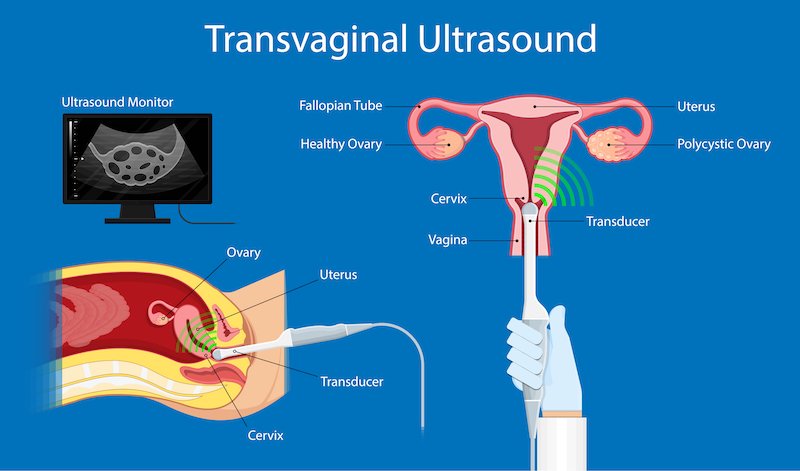
Transvaginal ultrasound
Transvaginal ultrasound in Nagpur is an ultrasound that utilises a transducer placed inside the vagina that could create images of structures and pelvic organs. The evaluation might be required sometimes for purposes such as:
1. Evaluation of a uterus, ovaries, or cervix
2. Detection of gynecologic conditions like fibroids, cysts, and cancer
3. Monitoring pregnancy and fetal development
4. Evaluation of pelvic pain or discomfort
5. For the guidance of biopsies or tumor treatments
6. Evaluation of pelvic injuries or trauma
What is Transvaginal Ultrasound?
– It is a pelvic ultrasound that employs a transducer introduced into the vagina
– It generates images of the pelvic structures and organs
What is TVU used for?
– It assesses the uterus, cervix, and ovaries
– Can detect gynecologic conditions such as fibroids, cysts, and cancer
– Monitor the pregnancy and the development of the fetus
– Assess pelvic pain or discomfort
– Assist in performing a biopsy or treating a tumor
– Assess the pelvic injury or trauma
Advantages of TVU
– Higher resolutions than what is observed in transabdominal ultrasound
– Improved evaluation of a pelvic organs and structures
– Improved detection for gynecologic conditions
– Helps in the biopsies and treatment of tumors
– Evaluation of pregnancy and development of the fetus
Preparation for TVU
– The patient does not the require any special preparation
– The patient will be properly positioned with feet on stirrups
* Risks and Side Effects*
– Relatively mild pain and discomfort will be felt
– No radiation to the patient will be done
– No reported side effects up to the date
Who should do TVU
Radiologist or ultrasonographer
When not to perform TVU
– Vaginal stenosis, or other stenosis of vagina
– Active infection or bleeding of vagina
– Patient discomfort or anxiety
What Is a Transvaginal ultrasound?
A transvaginal ultrasound, also known as endovaginal ultrasound, is imaging technology that uses high-frequency sound waves to produce detailed images of female organs and structures of the pelvic region. In doing so:
– The transducer emits sound waves to the pelvic organs and structures
– The reflected sound wave is converted into images on a screen
– Images of the uterus, ovaries, cervix, and tissues are formed.
This is a test conducted through a transvaginal ultrasound to aid in the diagnosis of gynecologic issues including fibroids, cysts, and even cancer; follow the progression and formation of pregnancy; outline causes for pain or pelvic uneasiness; direct some kinds of biopsy or tumor treatment; and as part of assessing injury or trauma within the pelvic region.
This is a painless, safe, and non-invasive procedure intended to yield much useful information about the diagnosis and management of different gynecologic conditions.
Uses of Transvaginal Ultrasound:
Gynecological Examination:
Detect and monitor abnormalities like uterine fibroids, ovarian cysts, endometriosis, or uterine abnormalities.
Pregnancy:
Monitor early pregnancy to establish the location and viability of pregnancy and screen for ectopic pregnancies.
Document fetal heart rate and dilation of the cervix and placement of the placenta.
Infertility:
Review the ovaries and the endometrium and identify abnormalities that may be contributing to infertility and monitor follicular growth during fertility therapy, such as IVF
Pelvic Pain or Irregular Bleeding:
Causes of pelvic pain, unexplained vaginal bleeding, or menstrual irregularities are diagnosed.
Cancer Screening: Ovarian, uterine, or cervical cancer may be present.
What procedures Transvaginal ultrasound?
Transvaginal ultrasound procedures include:
1. Gynecologic ultrasound: Evaluates the uterus, ovaries, and cervix for conditions like fibroids, cysts, and cancer.
2. Obstetric ultrasound: Monitors fetal development and well-being during pregnancy.
3. Pelvic pain evaluation: Assesses the cause of pelvic pain or discomfort.
4. Biopsy guidance: Uses ultrasound to guide biopsies of pelvic masses or tumors.
5. Tumor treatment guidance: Uses ultrasound to guide tumor treatments like uterine fibroid embolization.
6. Pelvic injury evaluation: Assesses injuries to the pelvic organs and structures.
7. Congenital anomaly evaluation: Evaluates congenital anomalies of the female reproductive system.
8. Postoperative evaluation: Evaluates the pelvis after gynecologic surgery.
9. Menstrual bleeding evaluation: Assesses the cause of abnormal menstrual bleeding.
10. Fertility evaluation: Evaluates the pelvis in patients with infertility or recurrent miscarriage.
Please note that the specific procedures and their components may vary depending on individual circumstances and healthcare provider recommendations.
At our Neurosys Multispeciality Center, we perform several key procedures including Craniotomy, which is primarily for the excision of brain tumors; V-P Shunt Surgery for treating hydrocephalus; surgeries for epilepsy; and operations targeting brain stem glioma. Beyond these, we offer a range of other neurosurgical services. If you have any questions that are not answere, please contact us through our Contact Us or Book your Appointment.
